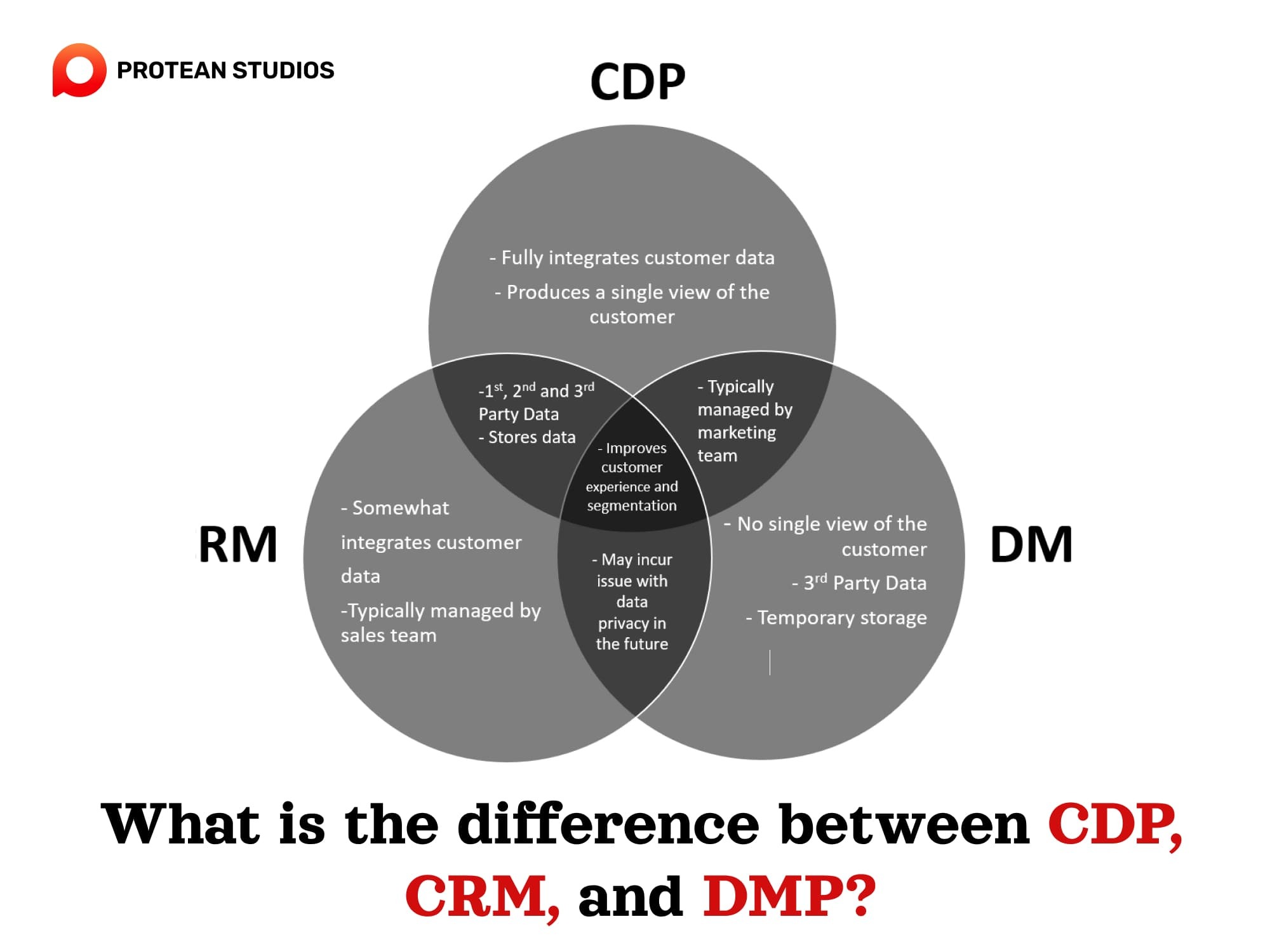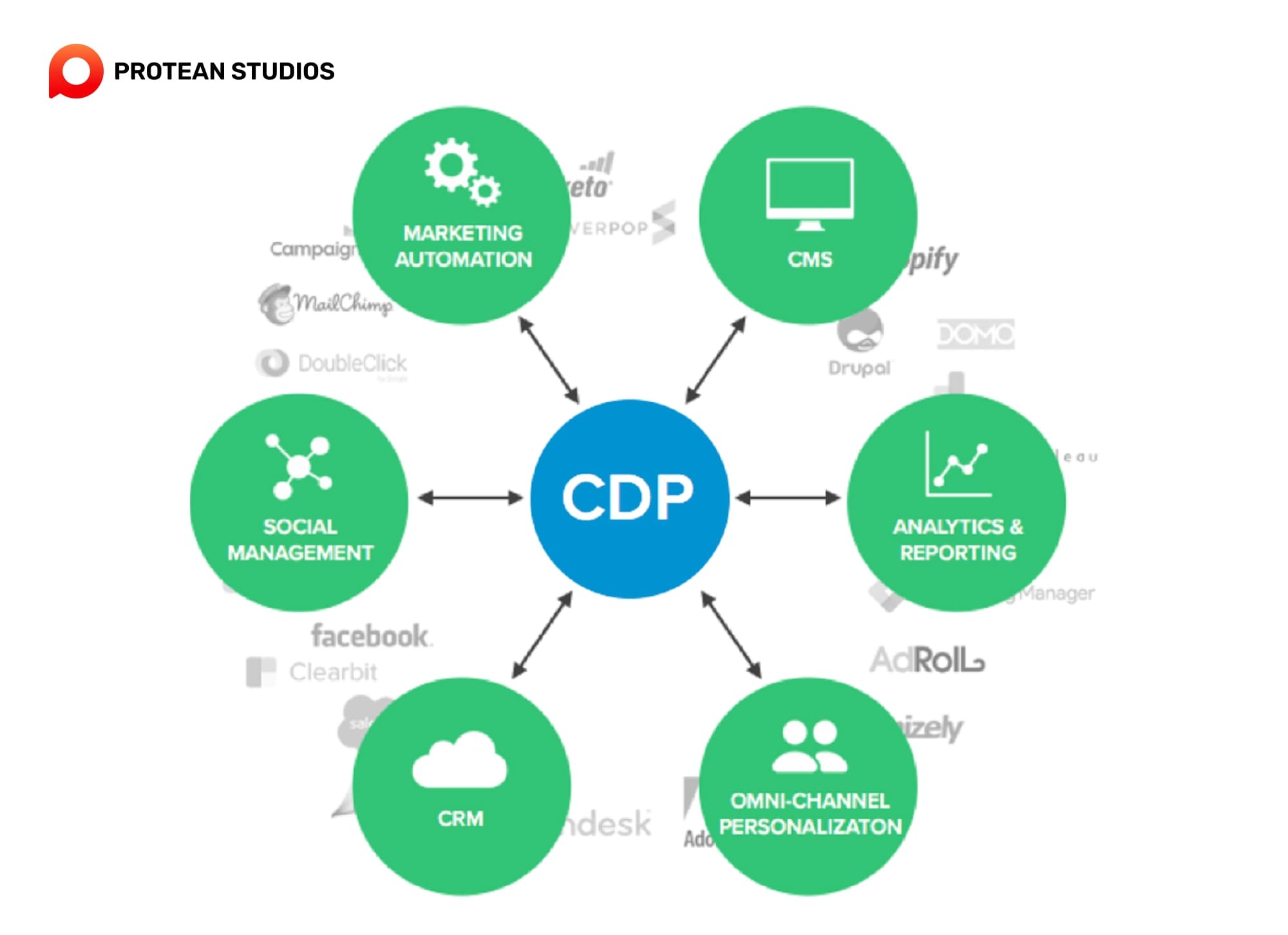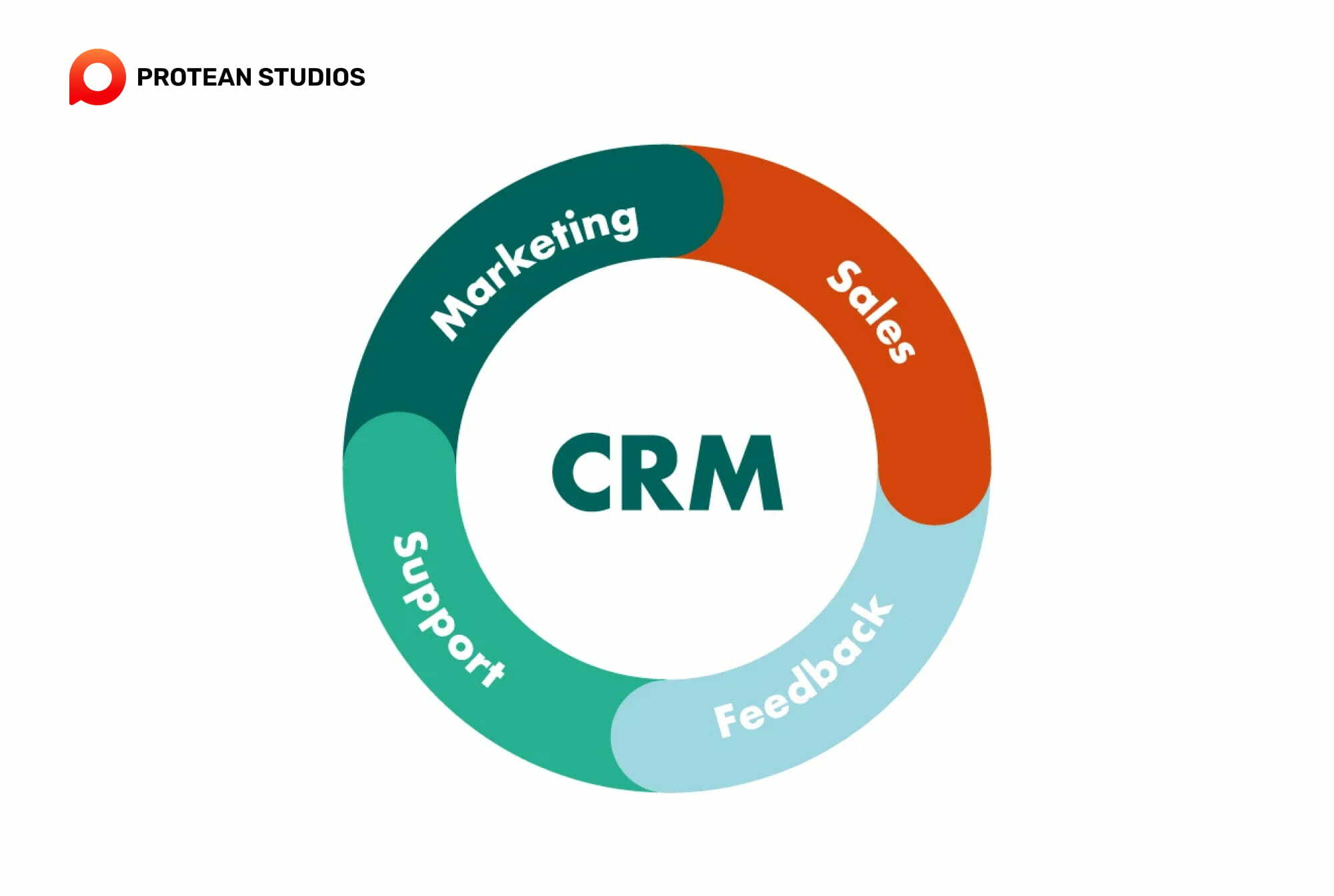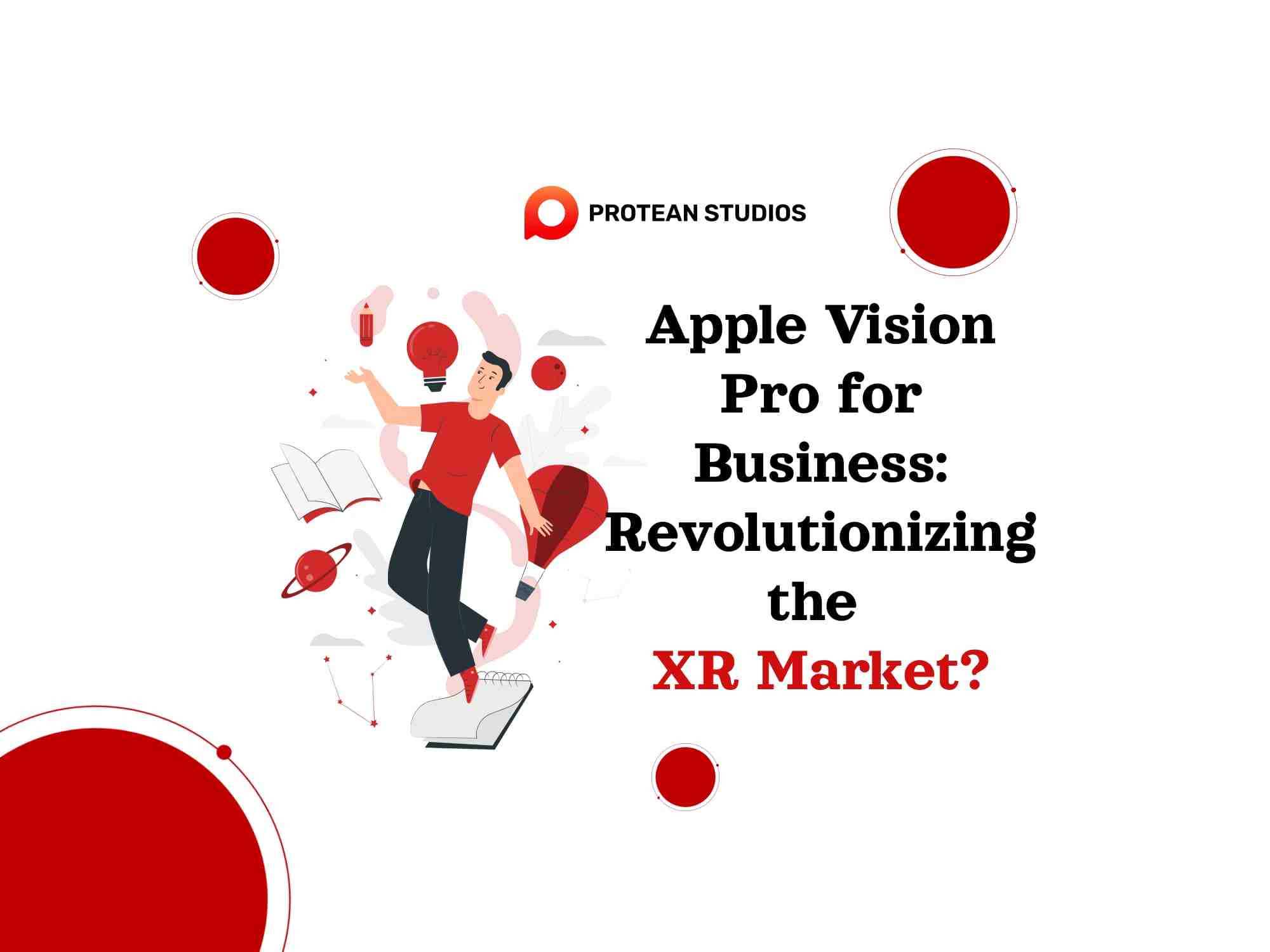
In the world of marketing technology (MarTech), three popular tools for handling customer data are CDP (Customer Data Platform), DMP (Data Management Platform), and CRM (Customer Relationship Management). Even though they have some things in common, each tool has its own special features and issues.
Thus, in the article, we will delve into the differences between these platforms and their role in managing customer data and improving the customer experience.
Understanding CDP, CRM, and DMP
The key distinction between a DMP, CDP, and CRM lies in how they use customer data. Whether it's for managing existing customers, targeting potential ones, or creating a unified customer profile, each platform serves a unique purpose.
1. CDP
A customer data platform (CDP) constructs a comprehensive customer picture. The reason is that it collects data from various sources, including websites, customer mobile apps, service interactions, physical store visits, and other platforms like CRM or DMP. Although it deals with first-party data, a CDP synthesizes diverse data points to create a unified and actionable customer profile, offering detailed insights for effective engagement across the sales pipeline.

Learn more: Customer Data Platform (CDP) and All Basic Knowledge
2. DMP
A data management platform (DMP) focuses on targeting audiences by pulling user data from third parties. It anonymizes this data and shares it with other companies for targeted advertising. While DMPs enhance digital marketing efficiency, their anonymous nature poses a challenge as they don't connect with existing user information. The future of DMPs remains uncertain due to changes in online tracking strategies and increased tracking protection.
Read more: The Best Data Management Platforms of 2024
3. CRM
A customer relationship management (CRM) platform concentrates on managing relationships with existing customers and leads. It organizes sales history, contact information, and individual communications. Customer service and sales teams often use these platforms; CRMs aid in projecting sales pipelines and foster collaboration among different departments.

What is the difference between CDP, CRM, and DMP?
All three platforms serve distinct roles in the marketing world, yet there can be some overlap. Their common goal is to enhance the customer experience, simplifying targeting and segmentation.
1. CDP vs. CRM
A CRM is where sales, service, or marketing teams handle customers and update data. It's used to compile all interactions with a customer, such as sales calls, contact center records, and support. But CRMs are more limited in application compared to CDPs because they address fewer use-cases and are less adept at integrating with various customer data sources.
An enterprise-grade customer data platform can gather data from all customer-facing systems. It includes website analytics, in-store point-of-sale systems, billing systems, and more.
Other article: Exploring CRM Software in Project Management
2. CDP vs. DMP
A DMP monitors third-party user behavior, storing data briefly, and it works as a third-party browser cookie ID. It aids in aggregate-level look-alike modeling and targeted paid media spend but falls short when it comes to creating detailed profiles of individual, identifiable customers.
While a CDP can perform some DMP functions, DMPs are specialized for advertising and customer acquisition campaigns. They excel with new or anonymous audiences, connecting sessions through third-party cookies. Operating on a massive scale specific to audiences, DMPs have limited data retention but prove valuable for generating lookalike audiences and executing programmatic advertising.
3. CDP vs. CRM vs. DMP

To know more about the differences between the three platforms, you can see the table below.
Feature | CDP | CRM | DMP |
Data Source | 1st-party (PII) + 2nd-party + 3rd-party (limited) | 1st-party (PII) + 2nd-party | 2nd-party + 3rd-party (anonymous) |
Focus | Unified customer profile | Customer relationships | Audience segmentation |
Data Type | Structured and semi-structured | Both structured and unstructured | Anonymous and unstructured |
Primary Users | Marketing teams | Sales and customer service | Marketing and advertising |
Goal | Personalize experiences | Manage and nurture leads. | Target and deliver ads |
Compliance | Stricter due to PII usage | Moderate | Less strict (anonymized data) |
How do you get the best platforms for data management?
Choosing the right platform for your team depends on your business needs and objectives. Consider the issues you need to address or the processes you aim to enhance.
If you seek to enhance internal processes and the customer experience, a CRM can streamline operations, bringing efficiency and organization to areas that may be lacking.
For those aiming to boost leads through outbound marketing, a DMP can elevate your digital advertising endeavors by enhancing spend with more targeted ads.
If uncovering new customer insights is a priority, a CDP consolidates customer data, aiding in segmentation and revealing correlations that may go unnoticed otherwise.
Embarking on the journey with DMPs, CDPs, and CRMs
DMPs, CDPs, and CRMs stand as robust and invaluable platforms for businesses. While they all handle customer data, each platform's distinctive purpose dictates how it organizes and processes that crucial information. Thus, you need to consider your goals and data marketing to improve your business’s performance, as follows:
Set SMART goals: specific,achievable, measurable, relevant, and time-bound. What do you want to achieve and use with these tools? (e.g., increase data marketing campaign ROI by 20% in the next year.)
Identify your data landscape. Understand the data you collect (structured, unstructured, PII), its sources (1st, 2nd, 3rd party), and any existing data silos.
Meet your needs. Which platform is the best for your goals? Consider factors like budget, resources, features, and data types.
Start small and scale: Begin with a pilot project focusing on a single platform or a specific department. This allows for learning and adjustments before wider implementation.
In conclusion, you need to understand the whole difference between CDP, CRM, and DMP to deploy them into your marketing strategy. Especially when following these steps and maintaining a data-driven marketing approach, you can embark on a successful journey with DMPs, CDPs, and CRMs. Then, unlock valuable insights to transform your customer relationships and achieve your business objectives.




